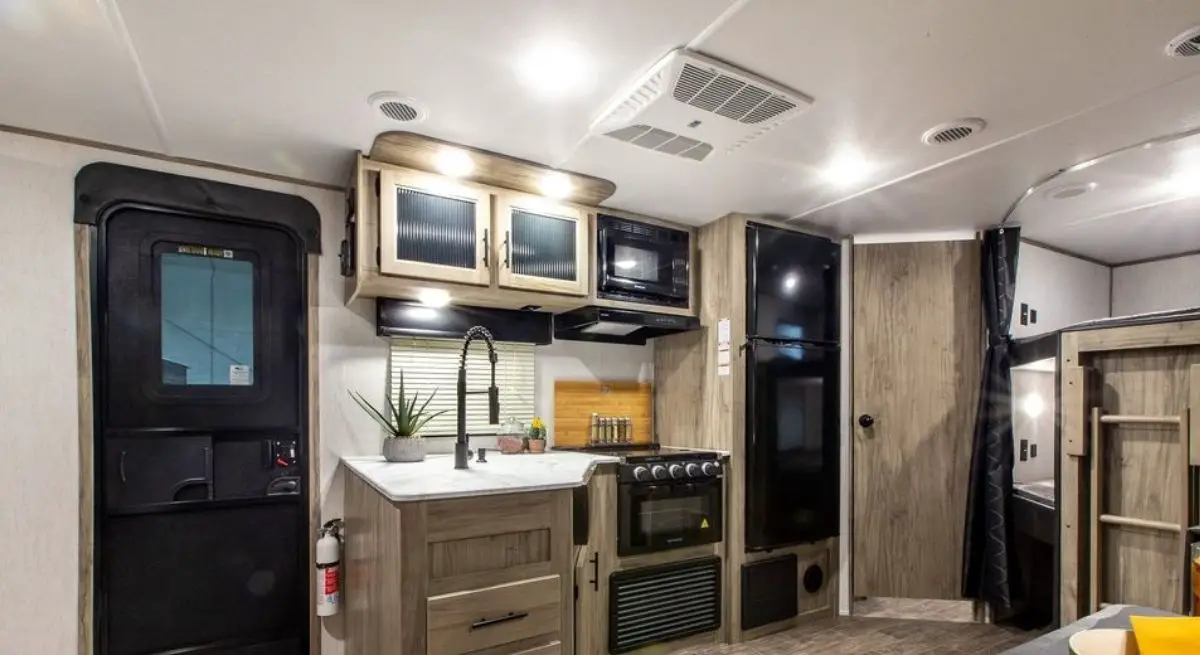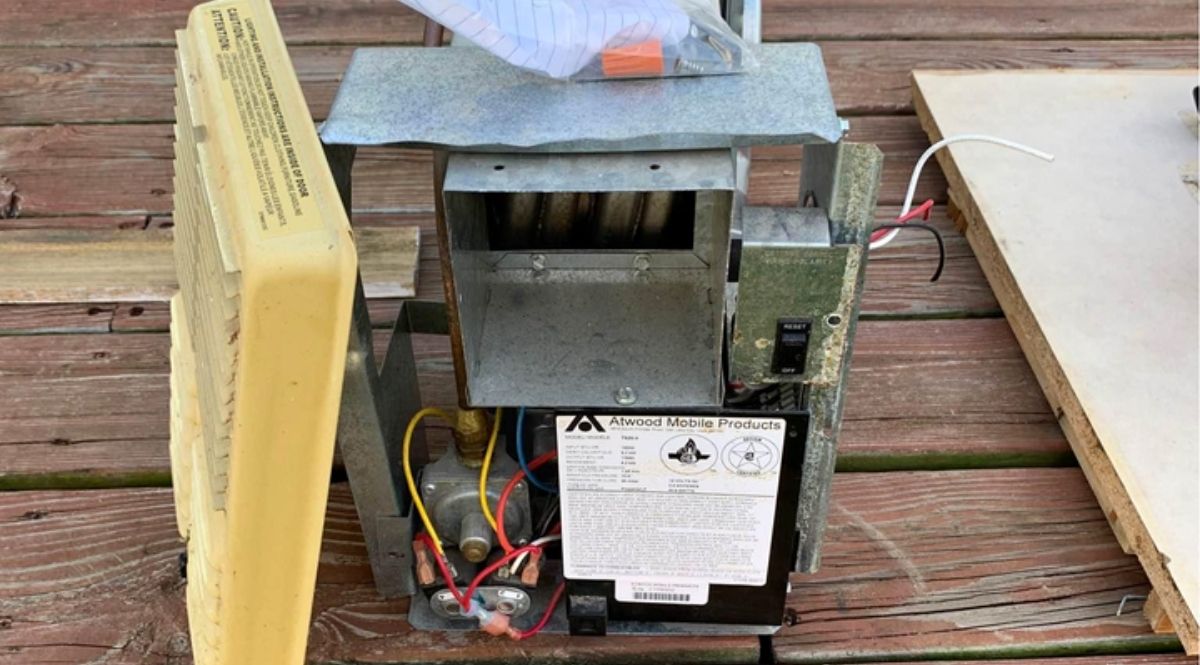Recreational vehicles are cool compared to houses since they are not designed to be used year-round in our cold northern climates. However, given the typical seasons in which most operate, contemporary insulation is sufficient to keep an RV cool on warm summer days and warm on cool spring and fall nights. To do so, they require insulation, but that insulation has a lower R-value than house walls.

Unlike mobile homes or modular homes, which must meet conventional home building code standards, RVs have no universal government-imposed building code to which they must adhere. It is the buyer’s duty to explore the unique materials and design qualities that meet their individual needs. The RV Industry Association (RVIA) provides self-imposed, universal standards for construction, but these are not government-set and inspected standards.

Since manufacturers of RVs—Class A, B, and C motor homes, pop-up trailers, park model trailers, and travel trailers are found across North America, many build to local preferences. This leads to differences in such features as windows, winter packages, water storage, electrical systems, building materials, and types or amounts of insulation.
Because of the variability of design, it is difficult to declare what the R-value of an RV maybe, because it varies from lows of R-5 in walls to highs of R-20 or R-25 in roofs and floors. This R-value is a measure of how warm RVs will be, in general.

But the RV shell is constructed to consider other factors, such as interior space, weight, structural integrity, and flexibility while towing. Thinner walls provide more interior space. Since exteriors of highway-capable trailers may not exceed eight feet for most types of trailers and motorized RVs, making walls thinner is desirable, but reduces the cavity space in which insulation may fit.
Lighter weight saves fuel and helps to keep a unit under very specific highway towing weight restrictions. Structural integrity increases when rigid insulation is fitted tightly between joists and studs so that the trailer does not sway or twist excessively while traveling.
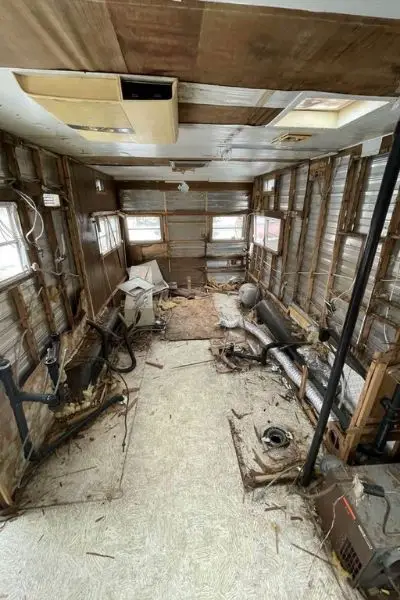
Because of the delicate balance, RV manufacturers maintain between weight, structural strength, aesthetics, and comfort, insulation R-values, which reflect the ability of the trailer to maintain heat or cool, are sacrificed somewhat.
What Is R-Value?
R-value is a comparative figure, with the R-value of air being R-1. It measures the effectiveness of a medium to reduce the flow of heat or resistance. The higher the R-value, the more effective the insulation will be.

In windows, the heat transfer calculation uses a U-value, but U- and R-value both serve the same purpose, even though the methods of calculation are different. With the U-value of a window, the lower the value, the more efficient the window is. As the U-value becomes lower, the lower the amount of conduction of heat that occurs between hot and cold.
R-value or U-value measures are useful for obtaining a standard reference as to how well one building is insulated against heat and cold versus another. Most of us assume that insulation and R-values of the insulation indicate how much heat we lose in our homes or campers, but, for most of the summer, it is a measure of how much heat we gain from the outside air and sun.
Read more: Keeping the Heat In
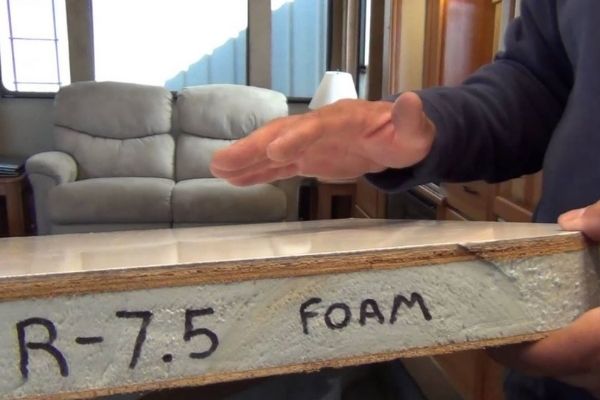
What Is The R-Value Of RV Walls And How Does This Relate To A House R-Value?
While heavily insulated RV walls may have an R-value of R-10 and R-20 for ceilings, this is much lower than houses, which must have a minimum R-25 or R-32 in walls.

The exterior shells of all RVs are thinner than homes, which now require six-inch walls. The majority of RVs have 1.5-inch wall cavities, restricting the amount of insulation that builders can install.
Older RVs had as little as R-5 wall insulation, R-10 in the ceiling, and, in some cases, no floor insulation.
The R-value largely is dictated by the types of insulation.

While all trailers that use rigid insulation employ closed-cell, dense materials, this type of insulation has limitations. Rigid insulation sheets do not fit tightly in irregular spaces. They either must be heat-pressed into place or back-filled with spray foam around fixtures, openings, and odd-shaped structural elements. In lower-priced RVs, the care needed to ensure the complete seal of the shell may be lacking.
Rigid, foam insulation has an R-value of 6.5 per inch of thickness, while open-cell spray foam is rated at 3.5 per inch and fiberglass at R-2.2. In addition, fiberglass deteriorates over time and is susceptible to mold, while rigid foam does not.

Depending on the year when your unit was built and the manufacturer or product line, there may be three different types of insulation used: friction-fit fiberglass insulation, rigid foam panels, or spray foam insulation. In many instances, older RV trailers might have two different insulation styles. For instance, the floors may have rigid panels and the walls friction-fit insulation.
The RV wall depends on other qualities, besides insulation, like the color of and materials used in the walls to reflect heat. However, insulation is essential for air conditioning, or heaters, to compensate for outside air temperature and loss of heat or cooling.

What Are RV Walls Made Of?
Older trailer walls used to be constructed of simple aluminum panels over a two-inch by two-inch stud framework, while many new ones use Azdel composite walls. The insulation consisted of fiberglass sections with a tarred paper backer to act as a vapor barrier.

The interior wall material often was medium density wallboard or 1/8-inch hardboard, and sometimes a variation with a wallpaper-style of finish. This style of construction tended to offer little insulation against the elements, and the aluminum panels frequently leaked, allowing wind-driven rain to penetrate.
As more manufacturers emerged and RVing gained popularity, there was a need for lighter trailers. Some “ultra-lights” were constructed using steel channel studs, which decreased lateral stability. In these units, rigid, heat-pressed insulation often replaced fiberglass insulation, to provide more solid framing.
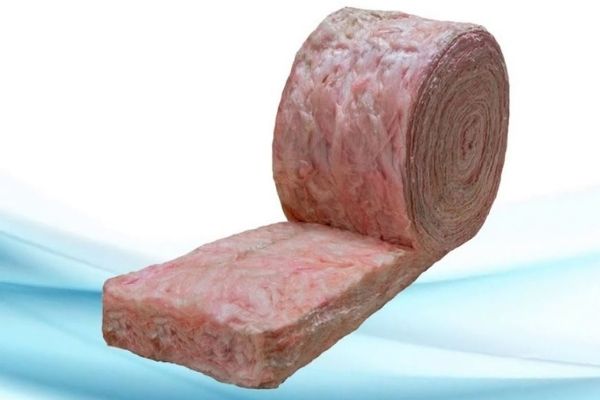
Floors often have rigid foam insulation, which also creates a more stable floor, while fiberglass, the least expensive option, is common in the walls and roof. More expensive RV units may use spray-in insulation or heat-sealed rigid foam, but it is both heavier and more costly. The friction-fit batts, like the sound-deadening insulation in car doors, may vibrate loose over periods of travel, creating pockets where there is no insulation in the walls.
Next, stretched aluminum skins were substituted for the aluminum panels. These skins resisted moisture penetration better but dented and marked easily.
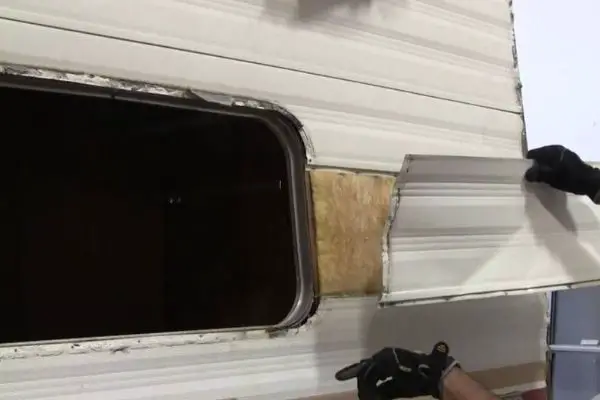
More advanced generations of trailers moved to fiberglass exterior skins, uniform and seamless. They resisted wind and rain, lasted longer but faded as quickly or quicker than painted aluminum. At the same time, the wall framing reverted to wood, with heat-pressed or spray-in foam insulation.
Inside, 6- or 10-ml polyethylene plastic replaced tar-coated paper as a moisture barrier, and interior paneling replaced hardboard or MDF panels.
Windows, too, saw evolution, from louvered, leaky crank-out single panes to double panes in upscale models, sliding casement windows, or horizontal and vertical awning windows, all more energy-efficient than their predecessors.
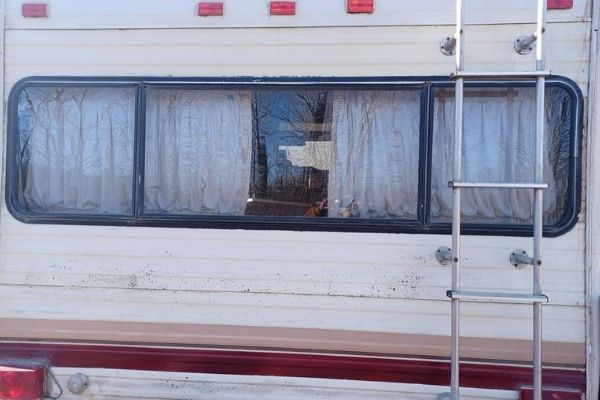
In 2006, Azdel, a proprietary brand-name material, was introduced as a framework for walls in many brands of RVs. This composite material consists of aluminum framing, polystyrene insulated core, exterior FRP fiberglass, and interior paneling. It is mold-resistant, weather-tight, and has good insulating value, up to about 4.5. While many RVs now use Azdel, not all do so.
The advances in wall construction and window style meant that these walls now were more energy-efficient, as well as more durable and attractive.
Related: What You Should Know Before Buying a Fiberglass Trailer
What Is The R-Value Of RV Roofs?
Older RVs have R-10 to R-15 ratings, while newer units (e.g. park models) may have R-20 or occasionally, R-25 to R-30.
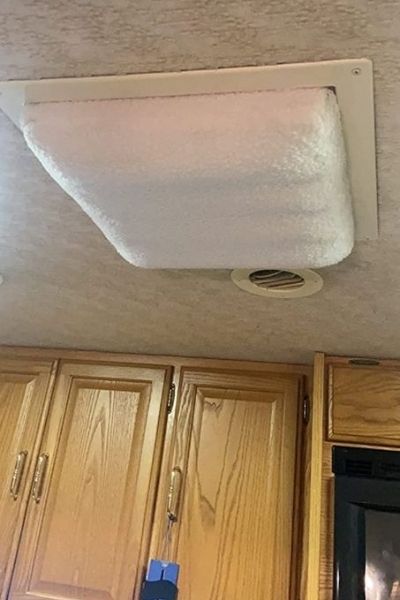
Most of the heat in the majority of structures is lost through the roof since heat rises and heat migrates to cold. Thus, manufacturers and designers place the emphasis on having better insulation in ceilings than in walls. This is true in recreational vehicles, as well.
Few travel trailers and RVs are high enough to worry about bridge or overpass clearances. Consequently, they can increase the height of each unit and make thicker roof truss designs, capable of containing more insulation.
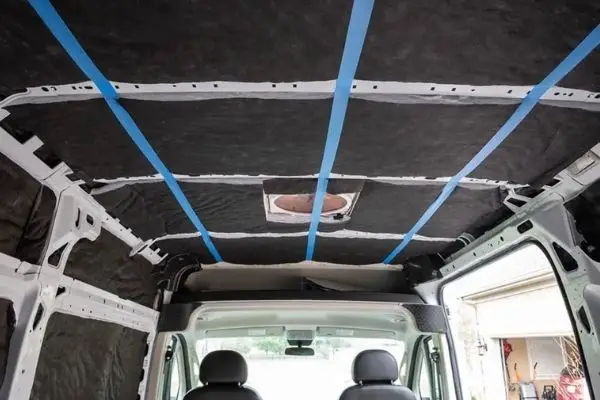
Still, depending on the structural design and materials used in construction, R-values will vary from manufacturer to manufacturer, model to model.
Trailer roofs almost always have a higher insulating value than the unit’s walls, but do not approach the efficiency of houses. Newer bungalows and even commercial buildings may have R-values of R-60, R-80, or higher, even though, at these higher ratings, the positive trade-off between energy savings and insulation costs becomes progressively less.
Do Four-Season RV Walls Have A Higher R-Value Than Conventional Trailers?
The question of whether a four-season RV has walls that have a higher R-value than regular trailers can not be answered with a simple yes or no.
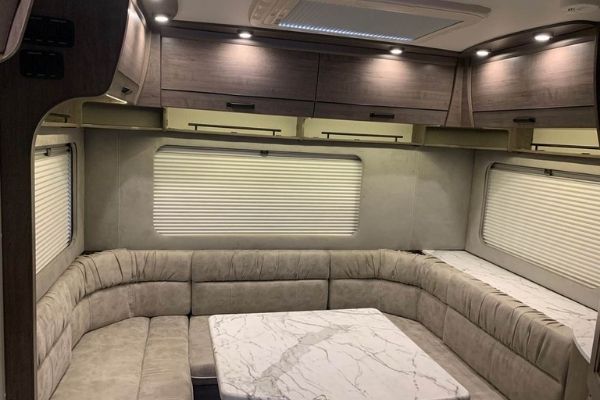
Because there is not a universal standard or building code for RVs, one manufacturer’s claim of being a 4-season trailer will not be to the same standard as another’s. Four-season trailers require numerous upgrades over standard RVs to make them true or even close to four-season-capable.
If a 4-season trailer does not have thicker walls than a regular RV, then it is almost impossible to provide a higher R-value with the same type of insulation materials. This applies to roofs, floors, and slide-outs.
There are other ways, though, to increase the capacity to withstand more extreme temperatures. This includes better sealing of gaps, upgraded windows and doors, insulated underbelly, protection for the storage tanks and water supply (including heaters), better furnaces and air conditioning units, and higher-quality, sealed exterior skins.
The best way to determine the ability of an RV to withstand extremes of weather is to examine, in detail, the construction parameters and specifications of each unit, conducting your own evaluation, rather than relying on the subjective claims of the manufacturer.
Related: How to RV in the Winter
What Is The R-Value Of RV Windows?
Windows provide avenues for the greatest transfer of heat and cold, but their conductivity is measured in U-values, not R-values. With the variety of windows, it is difficult to establish any uniformity to the general U-value or R-value equivalent of RV windows. Consider that a single pane of glass has an R-value equivalent of 1.0, making it as effective as air, while triple-pane, argon-filled sealed windows have a U-value of 0.4.
Since windows do not contain conventional insulation, the measurement of energy efficiency is that of how much heat is lost to conduction through the glass and frame. U-values that are lower mean windows that are better at resisting conduction of heat (glass is a poor conductor), but heat may be lost due to poor fit of windows, insufficient thermal bridging material, or lower quality of frame, sash, and seals.
Trailers built for northern climates may have double-paned, sealed windows, which increase their efficiency. Trailers destined for the southern markets, or lower-priced units, often have single-pane sliders or awning-style windows. Older trailers often had lattice-style openers, which were very inefficient.
Windows that are treated with heat reflective material provide greater protection against the intrusion of sunlight and solar heat.
Which RVs Have The Highest R-Value Walls & Roofs?
While each manufacturer may claim to have the best insulation, the types of trailers that have the best R-values are park models, designed to remain in place and be more like conventional mobile or modular homes.
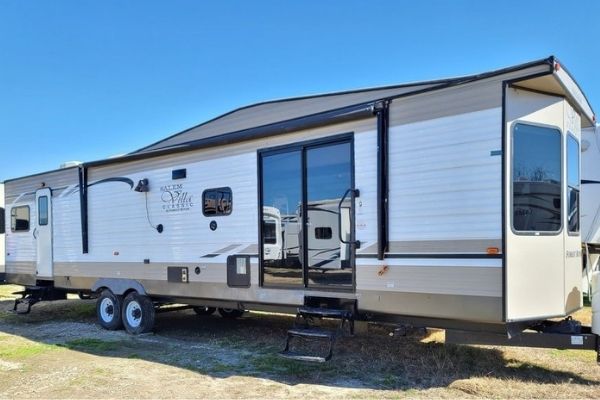
Four season packages may be better prepared for colder weather, but not necessarily have better wall insulation. Ultra-lights have poorer insulation still while pop-ups and Class C motor homes and conversion vans sacrifice R-value for style and mobility.
Fifth-wheel units provide the greatest capacity for enhanced R-value in roof and ceiling and make up for restricted width by having numerous “bump-outs.” In this way, walls can be thicker, because of the slide-outs increase usable floor space. Fifth wheel units also are less concerned with weight, as the bulk of the weight is not on a hitch but on a pivot in the back of the truck, allowing for greater trailer weight over conventional hitch mounts.

